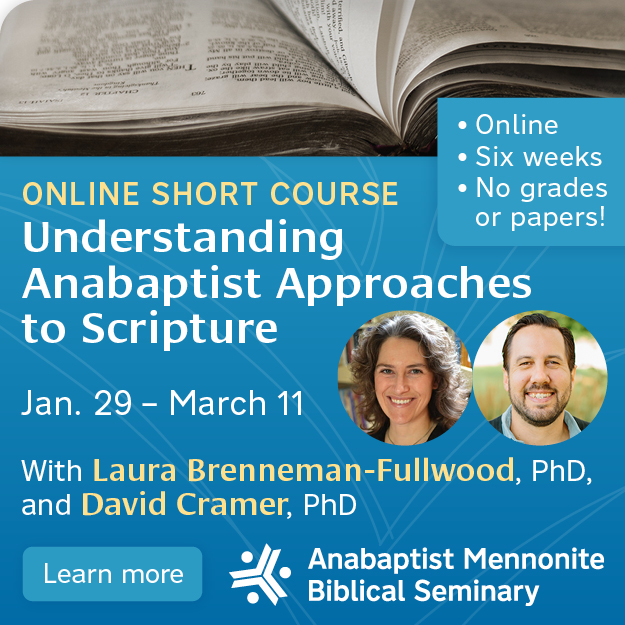Ephesians begins by blessing God for revealing the great mystery, namely, to “gather up all things in Christ” (1:10). Ephesians 2:11-22 then celebrates Christ’s making peace between strangers and enemies, breaking down walls of hostility through giving his life on the cross, thereby creating a “new human.” Fittingly, the exhortation to recipients of that grace begins in Ephesians 4:1-3 with a call to “walk in a way that is worthy of your calling,” which means to spare no effort “to maintain the unity of the Spirit in the bond of peace.”
Alas, unity seems to be eluding us these days, especially with respect to gender identity and sexuality. And our efforts to address our differences are often anything but peaceful. Unity and peace seem possible only if those we disagree with are gone, or at least are silenced.
Might the mess we’re in quite possibly be the result of the Spirit at work?
Let me explain: Ephesians 4:3 makes clear that unity is to be maintained. It exists already, created by the Spirit. Stated simply, unity is the premise—the precondition—for addressing what threatens to tear us apart. It is not the result of our successfully having done so.
Why is this unity such a messy affair? For one, God “gathers up all things in Christ,” including the hostility and estrangement that can mark human life. Humanity is being swept up into the One who is “our Peace,” transforming and recreating us into a “new human” at peace with each other and with God. That’s God’s peacemaking project, and the church is Ground Zero. Then, in 2:18, “we both”—we and those from whom we have been estranged—are brought into the presence of our divine parent “through one Spirit.”
“Spirit” translates pneuma, which can be rendered equally as “breath” or “wind.” The Creator gives “breath” to the “new human” (think Ezekiel 37). The “unity of the Spirit” is strangers and enemies breathing together as one body (Ephesians 2:16; 4:4).
“Wind,” on the other hand, “blows where it wills,” as do those who are “born of the wind/spirit” (John 3:8). The peace brought about by the Spirit is not the calm after the storm; it is God’s life-giving storm that blows down walls and breaks barriers, whooshing strangers and enemies together into God’s home (2:21-22). We should more accurately translate 4:3 as “keeping the unity of the Spirit with the chain of peace.” In this hurricane of grace and creation, you need chains to hold things together.
Does that fit a Mennonite vision of the church?
Historically, “without spot or wrinkle” (Ephesians 5:27) has played a greater role. The emphasis is not on bringing together “all things,” but on separation and holiness, a bride fit for the divine groom. With such a vision of church, schism became already very early in the Anabaptist movement a version of nonconformity to the world, where the “world” was those within the community deemed to be sinful or heretical. This has been dubbed the Täuferkrankheit, the Anabaptist disease. No doubt often a consequence of intolerance and struggle for power, schisms have also often resulted from eagerness to be faithful. In such cases, unity can feel like complicity, and peace like a bogus peace (think Jeremiah 6:14).
Not for a moment am I suggesting that we give up on a church “without spot or wrinkle.” It’s just that when we take that to be the starting point or baseline for what it means to be faithful, we will not be able to keep the unity of a Spirit who will keep bringing together strangers and enemies, along with all that made them such. If spotlessness is a starting point, unity can only ever be the result of agreement, or, when that is not possible, of the removal, distancing from, or departure of those who make agreement impossible.
Ephesians turns it around. Unity is the starting point, and wrinkle-free perfection the end point, possible only once all things have been gathered in, transformed and recreated. Unity is the arena within which the struggle with differences takes place, not the outcome of the struggle. Peace is the chain that keeps us at it, even when it hurts. That is where and how new creation takes place.
The New Testament shows clearly that the church has never been “without spot or wrinkle,” or even close. Moral laxity, ethical snobbishness, cynicism, power struggles and patriarchal privilege all played havoc in the church from the outset. Might this be a picture not only of sin, but also of the Spirit’s success? Is this what the “perfect” church looks like in a still-broken world?
When we read the New Testament with such a notion of perfection in mind, we see it everywhere. The same Jesus who calls people to repent, scandalizes his righteous critics by eating and drinking with sinners and gathering them into his inner circle. As he says to his critics: “Those who are well have no need of a physician, but those who are sick; I have come to call not the righteous but sinners” (Mark 2:17 paraphrase).
A perfect physician, a perfect hospital, welcomes illness and brokenness—in order to offer healing. Just so, a perfect church is God’s gathering of hostile, broken and ill humanity. Race, culture, gender, sexual orientation, wealth and theology all bring both their gifts and their divisiveness into the koinonia of the church.
The “unity of the Spirit” (Ephesians 4:3) or the “koinonia of the Spirit” (Philippians 2:1) is thus by divine design a turbulent unity. Chains are required. You don’t need chains for what wants to stay together, but rather for what strains to break apart. But such is the “perfect peace” in a world of estrangement and hostility that God is gathering up. In Matthew 5:43-48, Jesus equates being “perfect” with loving enemies. Might that include the enemy within the church?
Unity is not an end in itself
The unity of the Spirit is missional and transformative at its heart. It is inseparable from the one who is “our Peace.” We betray it when we refuse to bring stains and wrinkles into the church. We betray it no less when spots and wrinkles go unaddressed, when illness is not treated, when prevention is not counselled, to go back to Jesus’ physician metaphor. We dare not give up on each other—or disengage from each other—so as to keep the peace. Such is a false peace, even if it parades as tolerance. Such is not the unity of the Spirit.
Unity may well be the hardest part of being a faithful church. Given that we are always only the “new human” in the process of birth, constantly challenged by the broken humanity the Spirit keeps adding, we will “walk in a way that is worthy of our calling” only when chained to each other by peace. And what God has chained together, we dare not put asunder.
To walk together in this unity will never be elegant, but it will be graceful, marked by humility, respect, deference, compassion, patience and forbearance, which is nothing other than suffering each other in love (Ephesians 4:2-3; Philippians 2:1-4). You need such suffering, hopeful patience not for walking with those you like or agree with, but with those who strain the chain of peace to the breaking point. Paul calls that having the “mind of Christ” (Philippians 2:1-11), whose solidarity with humanity took him to the cross. Might “maintaining the unity of the Spirit” be taking up our own cross to follow Jesus?
Questions remain
Is “unity of the Spirit” the same thing as organizational unity? Surely not. We are rightly suspicious of empires and mega-corporations, and affirm the value of start-ups. That might apply to the church as well. But whatever distance or independence we might need must be within the unity, and in order to strengthen the unity of the Spirit. There is no “good riddance” in the unity of the Spirit.
Does—or should—patience ever run out? No doubt. It is, after all, patience, not impunity. But let’s not ask Peter’s impatient question: “Is seven times enough?” (Matthew 18:21). Patience’s stretch depends on suffering love and resilient hope, and for that reason must not be determined ahead of time. That is not a cop-out; it takes seriously the indeterminacy of “seventy times seven.”
By all means, let’s tug at the chain of peace, but within the unity of the Spirit. Let’s tug with patience and hope-filled love. Conversely, let’s respect the tug at the chain of peace as the exercise of covenant solidarity, even if that tug is painful and feels like judgment. Only so can we rightly claim to be a “peace church.”
Tom Yoder Neufeld is professor emeritus of religious studies and theological studies at Conrad Grebel University College, Waterloo, Ont.; he retired in 2012. Adapted from “Unsettled peace: The unity of the Spirit,” presented at the 18th Believers’ Church Conference, “Word, Spirit, and the renewal of the Church: Believers’ Church, ecumenical and global perspectives,” in Goshen, Ind., last September.
Viewpoint
‘We are the body together’
By Pieter Niemeyer, Special to Canadian Mennonite

“Peace is the chain that keeps us at it, even when it hurts.”
“If one member hurts, we all hurt.”
That God holds our unity has long informed my ecclesiology, discipleship and pastoral ministry. I take solace that nothing in my power can manufacture this unity; it is God-given and God-held. The question for all of us—and for me particularly as an LGBTQ person—is how to live into this unity in the face of harm done and hurt received. Like many others, I have discovered that there is no easy way when it regards those with whom I’d rather not be tied to.
I deeply appreciate Tom Yoder Neufeld’s feature article, “Unity of the Spirit: A perfectly messy peace,” wherein he unpacks Scripture with clarity regarding our unity, a unity of God’s peace that has broken down dividing walls and is “the chain that keeps us at it, even when it hurts.”
It’s a compelling vision for being church, one that rightly needs to place the “without spot or wrinkle” vision of church towards the other side of the eschaton. However, I wince at the phrase, “even when it hurts.” You see, the “without spot or wrinkle” hermeneutic has wreaked havoc on me and people like me. Based on such hermeneutics, we—as LGBTQ people—have been perceived as being the very spot/wrinkle to be erased. Like other oppressed peoples, we navigate a range of power dynamics that have left us battered and bruised. We are not equal partners in this pain, nor in this unity.
In addressing power dynamics among first-century Christians, Paul exhorts siblings in Christ to “bear one another’s burdens, and so fulfill the law of Christ” (Galatians 6:2). It is one of 30 such exhortations that remind us siblings to love one another, honour one another, think of one another as better than ourselves, and so on. These “one another” exhortations are to be prescriptive of this messy peace that binds us together.
However, my experience has been descriptively different: more being judged than loved, and of being burdened more than having them shared. It’s been more reflective of Jesus’ words in Matthew 23:4 than of Paul’s words in Galatians 6:2. Jesus said of the Sadducees and Pharisees of his day: “They tie up heavy burdens, with rules that are hard to bear and try to force people to obey them, but they are unwilling to help those who struggle under the weight of their rules” (Matthew 23:4). Jesus was addressing abusive interpretative approaches that diminish life. What’s at the heart for Jesus, and what Paul captures, is that the community of Jesus is one that inhabits mutuality rather than domination. Jesus said: “Take my yoke upon you, and learn from me. For I am meek and lowly in heart, and you will find rest for your souls” (Matthew 11:29).
You see, I am regularly contacted by hurting, restless LGBTQ people across various Anabaptist denominations, from Mennonite Brethren to Amish. Many of them struggle with thoughts of suicide, attempted suicide or depression as they can no longer sustain compartmentalized lives. Those married with children find the thought of coming out layered with complexities both overwhelming and painful. In the face of constant, condemning messaging, they feel alone within cycles of guilt, shame and defeat. The closet was not created by LGBTQ people, but it became a necessary survival mechanism in a hostile environment. Many of them are heavily burdened with fear at the prospect of coming out in such an environment; they have seen what others have suffered due to heavy chains.
Yes, we are chained together, and the hurting needs to stop. We cannot dismiss one another. In Christ, dividing walls are breaking down, and that holds my hope. It is a messy peace that we are to live into, but for far too many LGBTQ persons the mess has caused harm. And persistent messages like “no spot or wrinkle” obscure the peace.
I am committed to nurturing relationships with people who disagree with me; I believe in this vision of church. However, I want to encourage my straight/cisgender siblings in Christ to exercise greater care, awareness and accountability in the power dynamics of our “one another” relationship. As LGBTQ people, we are present—even if closeted—members of the body of Christ.
We have valid reasons to challenge the traditional hermeneutical lens through which LGBTQ matters have been understood, and we recognize this journey may be hard for you. We, too, value Scripture and are lovers of Jesus. Our lives and our gifts in the body of Christ are valuable. Your redemption and liberation are tied up with ours. We are the body together, and if one member hurts or is diminished, then all suffer because of it. Therefore, let us honour the body as we work out this messy peace that chains us together in Christ, even when it hurts, that we may witness to God’s extravagant and grace-filled love.
Pieter Niemeyer is an ordained Mennonite Church Eastern Canada minister and is currently in a time of transition. He attends Toronto United Mennonite Church.
For discussion
1. Tom Yoder Neufeld writes, “The peace brought about by the Spirit is not the calm after the storm; it is God’s life-giving storm that blows down walls and breaks barriers.” Can you envision that kind of peace? Can you think of examples of people being united in spite of deep differences?
2. Jesus said to love our enemies. Yoder Neufeld asks, “Might that include the enemy within the church?” Who might be your “enemy” within the church? What does it mean to love them? Is it possible that disagreements within the church are the Spirit at work?
3. Both Yoder Neufeld and Pieter Niemeyer suggest that a church “without spot or wrinkle” is not necessarily an expectation for the present. How much toleration do we have for “spots” in the church? Are we willing to suffer in order to keep the unity of the Spirit? How do we respond to the hurts of others in the church?
4. The church is facing major differences regarding gender identity and sexuality. Which view holds the balance of power in your congregation? What about the national and regional churches? What do we need to do to be a united body of Christ in the midst of this struggle?
—By Barb Draper










Leave a Reply
You must be logged in to post a comment.